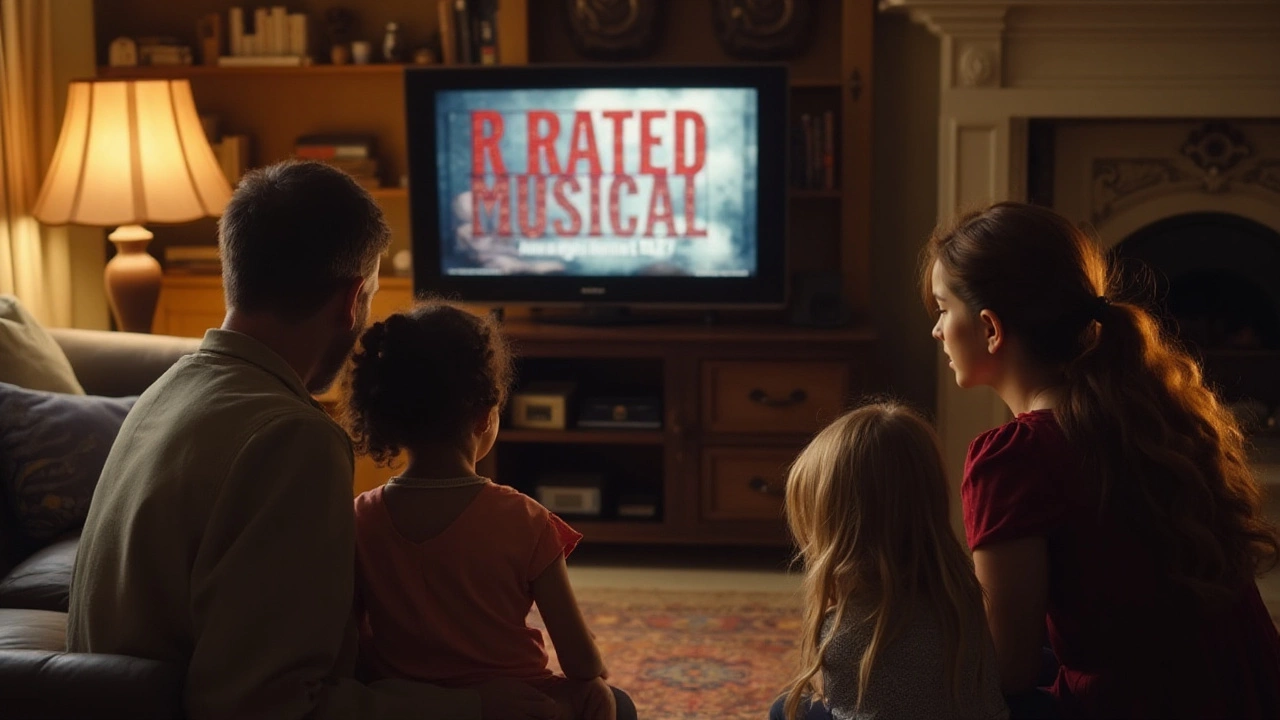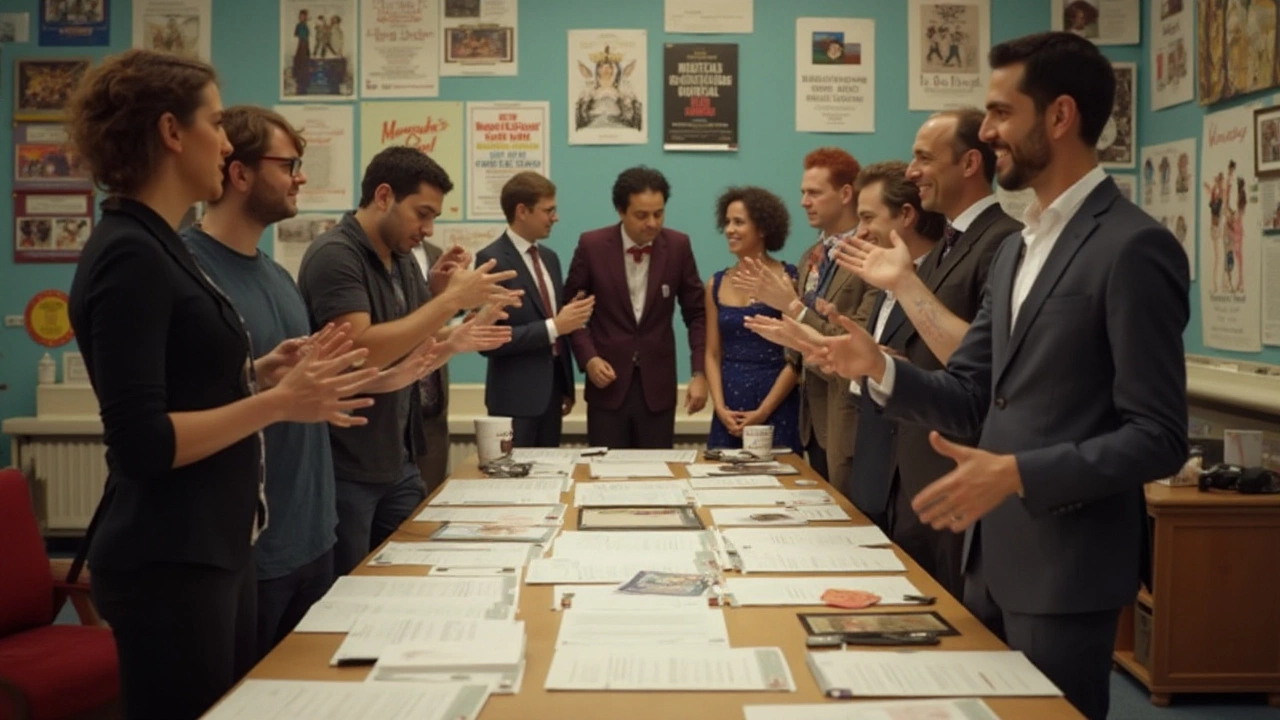When it comes to enjoying movies, age ratings often dictate what’s suitable for audiences—especially with children and teenagers in the picture. R-rated films, such as certain musicals, can spark curiosity and confusion. Many wonder if merely watching these films could have legal ramifications, particularly for younger viewers.
It's crucial to decipher these movie ratings. The R rating is a staple of the MPAA (Motion Picture Association of America) system, but not everyone understands its implications beyond the cinema. In this article, we untangle the threads of legality and guidance associated with these films.
Musicals with an R rating often delve into complex themes, incorporating mature material that requires a nuanced approach. This exploration isn’t just for cinephiles; it's also for parents, guardians, and educators seeking clarity on how best to navigate the cinematic landscape for various age groups. Step inside the world of R-rated musicals and uncover what these ratings truly mean for film enthusiasts.
- Decoding the R Rating in Film
- History and Evolution of Film Ratings
- R Ratings in the Context of Musicals
- Legal Considerations for Moviegoers
- Parental Guidance and Viewing Tips
Decoding the R Rating in Film
When it comes to film ratings in the United States, the R rating holds a significant place as a symbol of maturity intended content. Managed by the Motion Picture Association of America (MPAA), this classification is one of several designed to guide viewers on what to expect. At its core, an R-rated film requires accompanying adult supervision for viewers under age seventeen. The depiction of adult themes is more pronounced, often involving violence, strong language, sexual content, or drug use. This ensures that younger audiences are shielded from potentially inappropriate material that the filmmakers express without diluting the story's intent.
The history of film ratings traces back to the early 20th century when there were no codified rules or systems. As cinema gained popularity, a growing need emerged for a regulatory framework to manage content. This led to the creation of the Hays Code in the 1930s, a precursor to the MPAA's current system, focused on restricting content. The MPAA's more flexible ratings system was established in 1968 and has been refined over the years, allowing for a broader creative and expressive range within the industry while maintaining respect for audience sensitivities. While the R rating itself wasn't part of the original 1968 lineup, it was added in response to these changing societal values.
Understanding the specific nuances of R ratings in the context of modern filmmaking, especially within the realm of musicals, offers a fascinating glimpse into how these limitations and freedoms coexist. For instance, the 2001 film "Moulin Rouge!", a beloved musical, was assigned an R rating due to its depictions of sensuality mixed with heavy visual and emotional themes, challenging the typically lighthearted nature of the genre. As musical films have matured as storytelling forms, the depiction of complex narratives has required the application of the R rating to capture authenticity in human experience. Embracing these nuanced stories can lead to vibrant discussions about art and morality in pop culture.
For many filmmakers, receiving an R rating is a badge of honor—a sign of confidence that the authentic vision is being transmitted without censorship. Whether the material involves explicit language, themes, or altruistic cause depictions, a decision to adopt the R rating often represents the artist's commitment to truth. In support of this craft mentality, Quentin Tarantino has famously stated,
"I want to top expectations. I want to blow you away."His work exemplifies how sometimes an R rating strengthens the delivery of the intended message. Such sentiments reflect the collaborative understanding that ratings protect younger audiences, while serving as a hallmark of creative latitude for film. It becomes imperative to appreciate why such ratings exist, serving as more than mere labels but as indicators of a film's potential impact.
History and Evolution of Film Ratings
The landscape of movie ratings is as colorful as the films themselves, weaving a historical tapestry that reflects societal values, technological advancements, and regulatory shifts. Long before the familiar R, G, and PG letters danced across the screens, film content was often subject to the whims of local censorship boards. These boards, fragmented and inconsistent in their rulings, made movie-going a lottery depending on one's geographical location. It wasn't until the early 20th century that attempts to standardize content evaluation took root. The advent of the Hays Code in the 1930s aimed to govern moral conduct on screen, providing a loose template yet censoring creativity in its stringent outlines.
This imposed a sanitized layer over American cinema until the winds of change blew in the late 1960s. The studios recognized the growing tension between creative freedom and audience protection, leading to the conception of the MPAA rating system we know today. This novel structure, launched in 1968, offered a more nuanced view, guiding audiences with categories that suited a modernizing, diverse world.
Musicals, too, travelled through this evolution, their traditional family-friendly facade at times challenging the confines of these new ratings. With trailblazers like "Hair" and "Cabaret" pushing boundaries, the R rating emerged to embrace musicals infused with adult themes, declaring, metaphorically, a coming of age for the genre. The rating was not a barricade, but rather a beacon signaling that mature stories could be told through song.
"The ratings system evolves to accommodate not just protecting young audiences, but allowing filmmakers the liberty to explore societal intricacies without diluting their essence," according to Richard Heffner, former chairman of the MPAA.
This system continued to shift into the digital age, addressing unprecedented challenges like streaming services and international markets demanding tailored ratings. The interconnectedness of today's world necessitates harmonizing these systems, ensuring cultural sensitivity aligns with artistic integrity.
These changes are supported by data, capturing audience trends over decades. A review of percentages shows an increase in PG-13 and R-rated films since the 1980s, as seen in the data compiled by industry analysts:
| Year | PG-13 Films | R-Rated Films |
|---|---|---|
| 1985 | 20% | 25% |
| 2000 | 45% | 35% |
| 2020 | 60% | 30% |
Thus, what began as a means to impose morality evolved into an emblem of freedom, empowering filmmakers and audiences alike to sail into uncharted cinematic territories. This transformation advances the eternal song and dance of creation, where the question no longer remains if something is legal to watch, but what meaningful message it can deliver.

R Ratings in the Context of Musicals
Musicals, by their nature, blend storytelling with song and dance in a way that often captivates audiences across ages. However, the landscape of musicals is not as squeaky-clean as one might initially imagine. While many musicals carry a more family-friendly allure, there exists a niche of musicals that delve into mature and sometimes controversial themes, warranting an R rating. This classification means the content is intended for mature audiences, typically involving strong language, intense scenes, or adult themes that are not suitable for children or younger teenagers.
Historically, musicals have often taken bold steps to tackle societal issues and provoke thoughts about the world we live in. Films such as "Cabaret," with its dark Nazi Germany backdrop, or "Chicago," which thrillingly portrays crime and media sensationalism, exemplify how musicals can marry entertaining elements with profound narratives that are not child-friendly. An R rating in these cases ensures that audiences are mentally prepared for potentially startling or thought-provoking content. In such musicals, the interplay between the musical score and the thematic elements can create an experience that challenges as much as it entertains.
Take, for instance, the rocky yet glam rock-filled journey through "The Rocky Horror Picture Show." Its R rating mainly results from its unapologetic exploration of sexuality, something that was groundbreaking at the time of its release. The show defied norms and embraced individuality with fierce songs and eccentric characters, which became part of what makes it a cult classic. Its message might resonate with adults striving to strike a balance between conformity and self-expression, but it might be too intense for a younger demographic. The R rating is thus more of a protective measure, ensuring audiences are of the age to appreciate and understand these underlying themes with maturity.
In more recent times, movies like "Les Misérables" have skirted the line, sometimes flirting with strong PG-13 content due to its depiction of revolutionary violence and socio-political issues. It's a fine line that film creators tread, often influenced by the need to remain true to source material. The necessity for an R rating doesn't diminish their artistic value; rather, it highlights the creative foresight to present stories authentically. As filmmakers push boundaries, the inclusion of mature themes becomes almost inevitable, especially when narratives aim to reflect the complexities of real life.
The film industry uses ratings judiciously to cater to the broad spectrum of human experiences and emotions portrayed on screen. These musicals gain the R rating not just for shock value, but as a testament to the adult narratives they wish to communicate. They often serve as gateways for conversations about identity, society, and cultural norms. It's essential to look beyond the lettered label and explore the stories with the context of the era they represent or comment upon.
The research by the Center for Youth, Family, & Community Partnerships highlights the importance of viewing films through the lens of the era portrayed, as it provides deeper insights into cultural and historical context, particularly in musicals that push boundaries.In essence, R-rated musicals are a testament to the rich tapestry of storytelling formats that don't shy away from pressing issues, instead of using the artistic platform to challenge, inform, and instigate conversations while also celebrating the extraordinary magic of musicals.
Legal Considerations for Moviegoers
The conversation about legality when watching films, particularly R-rated musicals, often stems from misunderstandings about what these ratings truly imply. First, it is essential to clarify that it is not illegal for a person to watch an R-rated film in their own home, regardless of their age. However, legal concerns typically arise in the context of cinemas and public viewings. The Motion Picture Association of America defines the R-rating as a film containing adult material such as intense violence, sexual content, or strong language. As a result, viewers under 17 require an accompanying parent or adult guardian in theaters, but the enforcement of this can vary depending on local regulations and theater company policies.
Understanding where the legal boundaries rest requires a look into both local and state laws, as they can vary across regions. In many places, theaters must adhere to self-enforced guidelines, which are not legally binding but are often followed to maintain community standards and ensure customer trust. This self-regulation means that the onus partially lies with theaters to check IDs and restrict access when necessary. Some theaters even enhance this by offering wristband systems for easier monitoring of age restrictions on their premises. This practice ensures they comply with the intended spirit of the R-rating system and protect younger viewers from potentially inappropriate content.
Beyond the physical cinema walls, individuals absorb content differently in private settings. Streaming services and home rentals may suggest age appropriateness, leaving the choice to the discretion of parents or guardians. It's valuable to remember that while theaters might face fines or penalties for non-compliance with age checks, no legal action targets individuals for simply viewing these movies at home. That said, ethical considerations often prompt discussions about age suitability rather than legal enforcement. Discussing these parental guidelines supports responsible viewing and fosters a shared understanding between parents and younger audiences.
In certain instances, film studios and advocacy groups advocate for revised systems for categorizing films in response to public feedback. Helen Mirren once noted, "Film is one of the most accessible ways to broaden our minds, but we must balance exposure with responsibility when it's about young audiences."
"These distinctions protect audiences while empowering parents to make informed choices," she emphasized. Such insights stress the importance of maintaining a balanced system of film classification, safeguarding creativity, and respecting audience diversity.Understanding these legal considerations is part of a broader discussion about cinematic freedom and the responsibilities that come with it. It's an evolving discussion, enriched by input from filmmakers, audiences, and legal experts alike.

Parental Guidance and Viewing Tips
In the realm of R-rated musicals, parental guidance takes on a nuanced role beyond merely allowing or restricting access. Parents today navigate a diverse array of content, so understanding the implications of the R rating can empower them to make informed decisions. R-rated content typically contains material that may be unsuitable for children under 17, including adult themes, language, and situations that demand maturity to comprehend fully.
Given that the rating is a recommendation and not a law, parents have the ultimate discretion over what their children watch. Engaging in a dialogue with children about the themes within R-rated musicals can transform what might be a passive watching experience into a more interactive and educational one. Whether it’s exploring historical contexts of the narrative or understanding character motivations, the discussions can bridge generational gaps.
Establishing a pre-viewing routine helps parents manage expectations and set boundaries. For instance, previewing films before family movie nights gives insight into potential sensitive topics. Leveraging online reviews and parental ratings sites can offer a wealth of insights that mere trailers may not reveal. The aim is not solely to safeguard but to cultivate an understanding of the art form and the subjects it portrays.
“Access to different cultural products can serve educational purposes if discussed critically,” suggests film critic Roger Ebert. This perspective highlights how parents can utilize R-rated content as a teachable moment, embedding life lessons into leisure activities.
Practical tips for parents include watching the musical together as a family, allowing for real-time conversation about scenes as they unfold. Establishing a no-interruption policy keeps viewers engaged and attentive, fostering a deeper appreciation for the cinematic art. It’s also beneficial to schedule a follow-up discussion, perhaps over dinner, to revisit any moment or theme that seemed impactful or controversial.
Sometimes the most engaging viewing experiences are those where parents and children dive into the cultural or historical nuances of a film. This could involve the depiction of a particular era through costume design, musical score, or dialogue, allowing an exploration beyond surface-level viewing. The journey of digesting an R-rated musical becomes more than just watching; it’s about experiencing nuances together.



